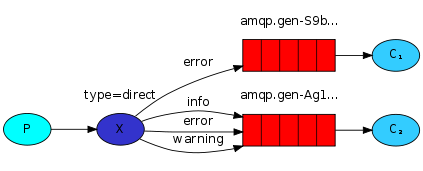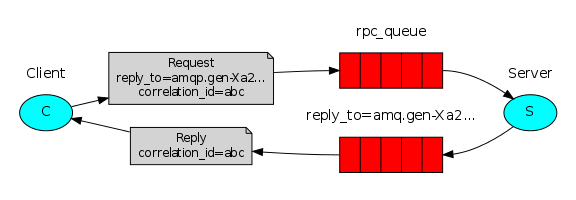RabbitMQ队列
基础
-
安装erlang: http://www.erlang.org/downloads
-
安装rabbitmq: http://www.rabbitmq.com
-
安装rabbitmq moudle: pip install pika
- RabbitMQ介绍:http://www.rabbitmq.com/tutorials/tutorial-six-python.html
- RabbitMQ web 登入: http://localhost:15672
RabbitMQ是一个消息代理:它接受和转发消息,类似邮局的角色。
实例一:
send端:
1 import pika
2
3 connection = pika.BlockingConnection(pika.ConnectionParameters('localhost')) # 建立连接
4 channel = connection.channel() # 声明一个管道
5 channel.queue_declare('hello') # 声明一个队列
6 channel.basic_publish(
7 exchange='',
8 routing_key='hello',
9 body= 'Hello Word')
10 # 发送消息
11 # routing_key : 队列名
12 # body: 消息内容
13 print('[x] sent "Hello World!"')
14 connection.close() # 关闭连接,channel不需要关闭receive 端:
1 import pika
2
3 connection = pika.BlockingConnection(pika.ConnectionParameters('localhost')) # 建立连接
4 channel = connection.channel() # 定义管道
5 channel.queue_declare(queue='hello')
6 # 声明队列,send端和recv端只需声明一次就好,但是不确定send端是否声明过,所以在两边可以都声明一次,这并不冲突
7
8 def callback(ch, method,properties,body):
9 """
10 收到消息,调用函数
11 :param ch: 管道
12 :param method:
13 :param properties:
14 :param body: 消息
15 :return:
16 """
17 print('reeive %r' % body)
18
19 channel.basic_consume(
20 callback,
21 queue='hello',
22 no_ack=True
23 )
24 print('wait for message.Press Ctrl+C to exit')
25 channel.start_consuming() # 持续接收消息,如果没有消息就阻塞执行结果:
- send端发送一条消息就结束
- recv端持续接受消息,一收到消息就调用回调函数,否则一直阻塞
- 如果send端没有打开,每次send的消息会存在rabbitmq服务器上,直到有recv端接入接受消息。
实例二:
RabbitMQ server采用轮询机制发送消息。开启多个recv端,send端发送消息,轮询recv端接收消息(每一次send,只会有一个recv端接收消息)
recv端 : channel.basic_consume参数no_ack=True recv端是否在调用完成回调函数后给send端一个确认;
-
- False:默认值,需要接收确认
- True:执行后不确认,也就是服务端把一个消息分发出去后就不管了
情景模拟:no_ack=False,回调函数添加消息处理完毕的确认语句:ch.basic_ack(delivery_tag=method.delivery_tag);在回调函数中添加sleep(),在recv端没处理完消息就中断,观察其他recv端的接受情况。


1 import pika
2 import time
3
4 connection = pika.BlockingConnection(pika.ConnectionParameters(
5 'localhost'))
6 channel = connection.channel()
7
8
9 def callback(ch, method, properties, body):
10 print(" [x] Received %r" % body)
11 time.sleep(20)
12 print(" [x] Done")
13 print("method.delivery_tag", method.delivery_tag)
14 ch.basic_ack(delivery_tag=method.delivery_tag)
15
16
17 channel.basic_consume(callback,
18 queue='task_queue',
19 )
20
21 print(' [*] Waiting for messages. To exit press CTRL+C')
22 channel.start_consuming()

1 import pika
2 import time
3
4 connection = pika.BlockingConnection(pika.ConnectionParameters(
5 'localhost'))
6 channel = connection.channel()
7
8 channel.queue_declare(queue='task_queue')
9
10 import sys
11
12 message = ' '.join(sys.argv[1:]) or "Hello World! %s" % time.time()
13 channel.basic_publish(exchange='',
14 routing_key='task_queue',
15 body=message,
16 properties=pika.BasicProperties(
17 delivery_mode=2, # make message persistent
18 )
19 )
20 print(" [x] Sent %r" % message)
21 connection.close()默认的no_ack=False的模式,如果一个消息没有确认,但是连接断了,那么这个消息还会有别的recv端重新处理。只有在recv端确认了之后,才会从服务器的队列中清除。
消息持久化
pika队列与消息都存在RabbitMQ server缓存中,如果server down机了,缓存将会被清空。因此,server端的数据丢失会造成send端与recv端的失联,所以,server对于重要数据需要进行消息持久化。
RabbitMQ说明:
-
- rabbitmqctl.bat list_queue : 列举server端的queue信息
- rabbitmq-servece.bat start: 启动service
消息持久化
-
- 队列持久化
channel.queue_declare(queue='hello', durable=True) - 消息持久化
channel.basic_publish(properties=pika.BasicProperties(delivery_mode=2,)) # make message persistent
- 队列持久化
消息公平分发
不同配置的机器,对于消息的处理速度不同,如果rabbitmq server只是按照顺序给多个机器发送消息,那么处理慢的机器可能会造成消息堆积,处理快的机器会长时间处于闲置状态。
因此,可以配置让rabbitmq server在一个机器没有处理完上一个消息时,不给其发送新的消息。只需在recv端配置如下:
channel.basic_qos(prefetch_count=1)
send端


1 import pika
2
3 connection = pika.BlockingConnection(pika.ConnectionParameters(
4 host='localhost'))
5 channel = connection.channel()
6
7 channel.queue_declare(queue='task_queue', durable=True)
8
9 message = "Hello World!"
10 channel.basic_publish(exchange='',
11 routing_key='task_queue',
12 body=message,
13 properties=pika.BasicProperties(
14 delivery_mode = 2, # make message persistent
15 ))
16 print(" [x] Sent %r" % message)
17 connection.close()recv端


1 import pika
2 import time
3
4 connection = pika.BlockingConnection(pika.ConnectionParameters(
5 host='localhost'))
6 channel = connection.channel()
7
8 channel.queue_declare(queue='task_queue', durable=True)
9 print(' [*] Waiting for messages. To exit press CTRL+C')
10
11 def callback(ch, method, properties, body):
12 print(" [x] Received %r" % body)
13 time.sleep(10)
14 print(" [x] Done")
15 ch.basic_ack(delivery_tag = method.delivery_tag)
16
17 channel.basic_qos(prefetch_count=1)
18
19 channel.basic_consume(callback,
20 queue='task_queue')
21
22 channel.start_consuming()消息发布\订阅
上面实例都是一对一的发送与接收消息,可以使用exchange实现一个发送端发送消息,多个接收端接收消息,即广播消息。
Exchange定义类型,用于判断哪些queue符合条件,可以接受消息。
-
- fanout: 所有bind到此exchange的queue都可以接收消息
- direct: 通过routingKey和exchange决定唯一的queue可以接收消息
- topic: 所有符合routingKey(此时可以是一个表达式)的routingKey所bind的queue可以接收消息,表达式符号说明:#代表一个或多个字符,*代表任何字符,( 注:使用RoutingKey为#,Exchange Type为topic的时候相当于使用fanout)
- headers: 通过headers 来决定把消息发给哪些queue
发布端


1 import pika
2
3 connection = pika.BlockingConnection(pika.ConnectionParameters(
4 host='localhost'))
5 channel = connection.channel()
6
7 channel.exchange_declare(exchange='logs',
8 type='fanout')
9
10 message ="info: Hello World!"
11 channel.basic_publish(exchange='logs',
12 routing_key='',
13 body=message)
14 print(" [x] Sent %r" % message)
15 connection.close()订阅端


1 import pika
2
3 connection = pika.BlockingConnection(pika.ConnectionParameters(
4 host='localhost'))
5 channel = connection.channel()
6
7 channel.exchange_declare(exchange='logs',
8 type='fanout')
9
10 result = channel.queue_declare(exclusive=True) #不指定queue名字,rabbit会随机分配一个名字,exclusive=True会在使用此queue的消费者断开后,自动将queue删除
11 queue_name = result.method.queue
12
13 channel.queue_bind(exchange='logs',
14 queue=queue_name)
15
16 print(' [*] Waiting for logs. To exit press CTRL+C')
17
18 def callback(ch, method, properties, body):
19 print(" [x] %r" % body)
20
21 channel.basic_consume(callback,
22 queue=queue_name,
23 no_ack=True)
24
25 channel.start_consuming()有选择的接受消息
RabbitMQ server根据关键字发送消息,即:队列绑定关键字,发送者将数据根据关键字发送到消息exchange,exchange根据关键字判定应该将数据发送至指定队列。

发布端:


1 import pika
2 import sys
3
4 connection = pika.BlockingConnection(pika.ConnectionParameters(
5 host='localhost'))
6 channel = connection.channel()
7
8 channel.exchange_declare(exchange='direct_logs',
9 type='direct')
10
11 severity = sys.argv[1] if len(sys.argv) > 1 else 'info'
12 message = ' '.join(sys.argv[2:]) or 'Hello World!'
13 channel.basic_publish(exchange='direct_logs',
14 routing_key=severity,
15 body=message)
16 print(" [x] Sent %r:%r" % (severity, message))
17 connection.close()订阅端:


1 import pika
2 import sys
3
4 connection = pika.BlockingConnection(pika.ConnectionParameters(
5 host='localhost'))
6 channel = connection.channel()
7
8 channel.exchange_declare(exchange='direct_logs',
9 type='direct')
10
11 result = channel.queue_declare(exclusive=True)
12 queue_name = result.method.queue
13
14 severities = sys.argv[1:]
15 if not severities:
16 sys.stderr.write("Usage: %s [info] [warning] [error]\n" % sys.argv[0])
17 sys.exit(1)
18
19 for severity in severities:
20 channel.queue_bind(exchange='direct_logs',
21 queue=queue_name,
22 routing_key=severity)
23
24 print(' [*] Waiting for logs. To exit press CTRL+C')
25
26 def callback(ch, method, properties, body):
27 print(" [x] %r:%r" % (method.routing_key, body))
28
29 channel.basic_consume(callback,
30 queue=queue_name,
31 no_ack=True)
32
33 channel.start_consuming()更细致的消息过滤
对于需要过滤不同应用程序的log,这里可以通过定义exchange的类型为topic来实现。
exchange topic的routing_key通过由'*’和'#'通配符以及字母符号等构成的表达式表示。
发布端:


1 import pika
2 import sys
3
4 connection = pika.BlockingConnection(pika.ConnectionParameters(
5 host='localhost'))
6 channel = connection.channel()
7
8 channel.exchange_declare(exchange='topic_logs',
9 type='topic')
10
11 routing_key = sys.argv[1] if len(sys.argv) > 1 else 'anonymous.info'
12 message = ' '.join(sys.argv[2:]) or 'Hello World!'
13 channel.basic_publish(exchange='topic_logs',
14 routing_key=routing_key,
15 body=message)
16 print(" [x] Sent %r:%r" % (routing_key, message))
17 connection.close()订阅端:


1 import pika
2 import sys
3
4 connection = pika.BlockingConnection(pika.ConnectionParameters(
5 host='localhost'))
6 channel = connection.channel()
7
8 channel.exchange_declare(exchange='topic_logs',
9 type='topic')
10
11 result = channel.queue_declare(exclusive=True)
12 queue_name = result.method.queue
13
14 binding_keys = sys.argv[1:]
15 if not binding_keys:
16 sys.stderr.write("Usage: %s [binding_key]...\n" % sys.argv[0])
17 sys.exit(1)
18
19 for binding_key in binding_keys:
20 channel.queue_bind(exchange='topic_logs',
21 queue=queue_name,
22 routing_key=binding_key)
23
24 print(' [*] Waiting for logs. To exit press CTRL+C')
25
26 def callback(ch, method, properties, body):
27 print(" [x] %r:%r" % (method.routing_key, body))
28
29 channel.basic_consume(callback,
30 queue=queue_name,
31 no_ack=True)
32
33 channel.start_consuming()RPC:remote procedure call
发送命令在远程机器上执行,并且返回执行结果。

RPC server:


1 import pika
2
3
4 connection = pika.BlockingConnection(pika.ConnectionParameters('localhost'))
5 channel = connection.channel()
6
7 channel.queue_declare('rpc_queue')
8
9
10 def upper_data(data):
11 if data:
12 data = data.upper()
13 else:
14 data = None
15 return data
16
17
18 def on_request(ch,method,props,body):
19 print('receive data:',body)
20 response = upper_data(body)
21 print('send data:',response)
22 ch.basic_publish(
23 exchange='',
24 routing_key=props.reply_to,
25 properties=pika.BasicProperties(correlation_id=props.correlation_id),
26 body=response
27 )
28 ch.basic_ack(delivery_tag=method.delivery_tag)
29
30 channel.basic_qos(prefetch_count=1)
31 channel.basic_consume(on_request, queue='rpc_queue')
32 print('[X] Waiting RPC request')
33 channel.start_consuming()RPC client:


1 import pika
2 import uuid
3 import sys
4 class RPCclient(object):
5
6 def __init__(self):
7 self.connection = pika.BlockingConnection(pika.ConnectionParameters('localhost'))
8 self.channel = self.connection.channel()
9 result = self.channel.queue_declare(exclusive=True)
10 self.callback_queue = result.method.queue
11 self.channel.basic_consume(self.on_response,
12 queue=self.callback_queue,
13 no_ack=True)
14
15
16 def on_response(self,ch, method, props, body):
17 if self.corr_id == props.correlation_id:
18 self.response = body
19
20 def call(self,data):
21 self.response = None
22 self.corr_id = str(uuid.uuid4())
23 self.channel.basic_publish(
24 exchange= '',
25 routing_key='rpc_queue',
26 properties=pika.BasicProperties(reply_to=self.callback_queue,
27 correlation_id=self.corr_id),
28 body=data
29 )
30 print('starting',data)
31 while self.response is None:
32 self.connection.process_data_events()
33 print('waiting',self.response)
34
35 return self.response
36
37
38 rpc = RPCclient()
39 data = ' '.join(sys.argv[1:]) if len(sys.argv) > 1 else 'Abctest'
40 response = rpc.call(data)
41 print('receive data:',response)
来源:oschina
链接:https://my.oschina.net/u/4288942/blog/4061601